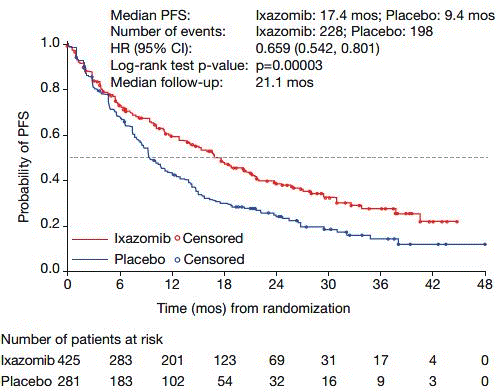EHA 2020: Ixazomib is Effective as Maintenance for Transplant Ineligible Myeloma Patients

Much of the maintenance therapy used in myeloma care includes immunomodulators like Revlimid or Pomalyst, but a presentation from the European Hematology Association 2020 meeting shows that the oral proteasome inhibitor ixazomib (Ninlaro) is an effective maintenance therapy in a placebo-controlled trial.
Using maintenance therapy after initial treatment can increase the time of remission, but if you become resistant to current classes of drugs, more options are needed.
The Phase III TOURMALINE-MM4 study compared ixazomib as maintenance vs. a placebo as maintenance for newly diagnosed myeloma patients who were not eligible for a stem cell transplant. The study included 706 patients who received 6-12 months of standard induction (first treatment) myeloma therapy. Seventeen percent of the patients had high risk disease.
Results were as follows:
| Ixazomib | Placebo | |
| Complete Response (CR) | 23% | 22% |
| Very Good Partial Response (VGPR) | 40% | 40% |
| Partial Response (PR) | 38% | 38% |
| Progression Free Survival (PFS) | 17.4 months | 9.4 months |
| PFS of Patients with CR or VGPR | 25.6 months | 12.9 months |
| PFS of Patients younger than 75 | 17.7 months | 9.3 months |
| PFS of Patients older than 75 | 16.7 months | 10.6 months |
| Time to Progression | 17.8 months | 9.6 months |

Dr. Meletios A. Dimopoulos and colleagues noted that using ixazomib as maintenance therapy for patients who are not headed to stem cell transplant provided a meaningful 34% reduction in the risk of myeloma progression or death and had a well-tolerated safety profile. A majority of patients experiences low level grade 1 or 2 side effects, the most common being nausea, vomiting and diarrhea.
As an oral drug, this may provide another convenient maintenance therapy option and according to Dr. Dimopouolos, may be potentially added with other agents such as immunomodulators and monoclonal antibodies in maintenance therapy combinations.
Much of the maintenance therapy used in myeloma care includes immunomodulators like Revlimid or Pomalyst, but a presentation from the European Hematology Association 2020 meeting shows that the oral proteasome inhibitor ixazomib (Ninlaro) is an effective maintenance therapy in a placebo-controlled trial.
Using maintenance therapy after initial treatment can increase the time of remission, but if you become resistant to current classes of drugs, more options are needed.
The Phase III TOURMALINE-MM4 study compared ixazomib as maintenance vs. a placebo as maintenance for newly diagnosed myeloma patients who were not eligible for a stem cell transplant. The study included 706 patients who received 6-12 months of standard induction (first treatment) myeloma therapy. Seventeen percent of the patients had high risk disease.
Results were as follows:
| Ixazomib | Placebo | |
| Complete Response (CR) | 23% | 22% |
| Very Good Partial Response (VGPR) | 40% | 40% |
| Partial Response (PR) | 38% | 38% |
| Progression Free Survival (PFS) | 17.4 months | 9.4 months |
| PFS of Patients with CR or VGPR | 25.6 months | 12.9 months |
| PFS of Patients younger than 75 | 17.7 months | 9.3 months |
| PFS of Patients older than 75 | 16.7 months | 10.6 months |
| Time to Progression | 17.8 months | 9.6 months |

Dr. Meletios A. Dimopoulos and colleagues noted that using ixazomib as maintenance therapy for patients who are not headed to stem cell transplant provided a meaningful 34% reduction in the risk of myeloma progression or death and had a well-tolerated safety profile. A majority of patients experiences low level grade 1 or 2 side effects, the most common being nausea, vomiting and diarrhea.
As an oral drug, this may provide another convenient maintenance therapy option and according to Dr. Dimopouolos, may be potentially added with other agents such as immunomodulators and monoclonal antibodies in maintenance therapy combinations.
about the author
Jennifer Ahlstrom
Myeloma survivor, patient advocate, wife, mom of 6. Believer that patients can contribute to cures by joining HealthTree Cure Hub and joining clinical research. Founder and CEO of HealthTree Foundation.
More on Treatment Advances
Trending Articles




Get the Latest Multiple Myeloma Updates, Delivered to You.
By subscribing to the HealthTree newsletter, you'll receive the latest research, treatment updates, and expert insights to help you navigate your health.
Together we care.
Together we cure.
3x Faster.












